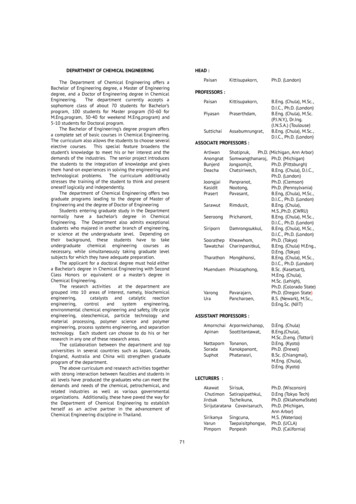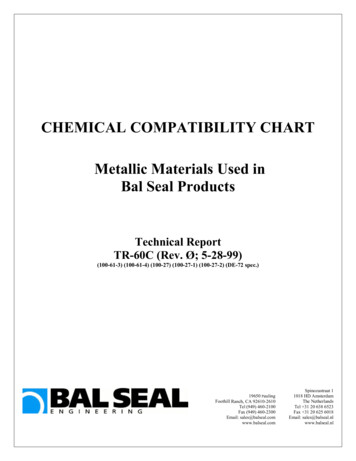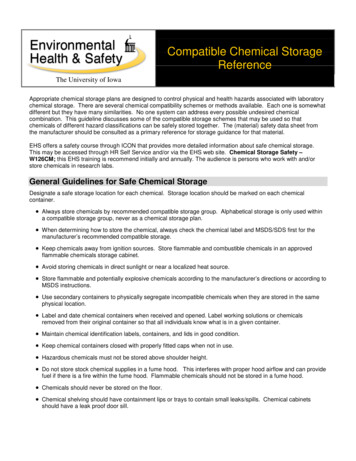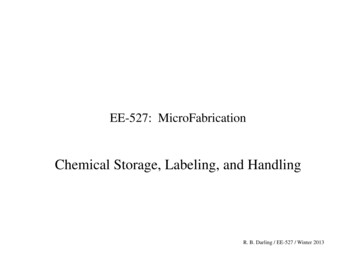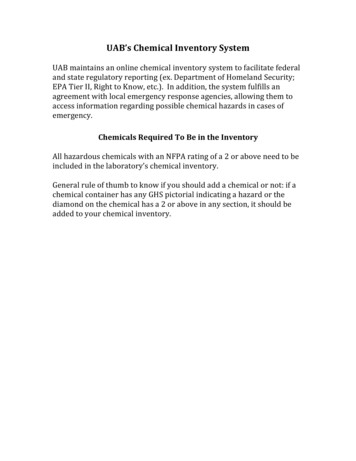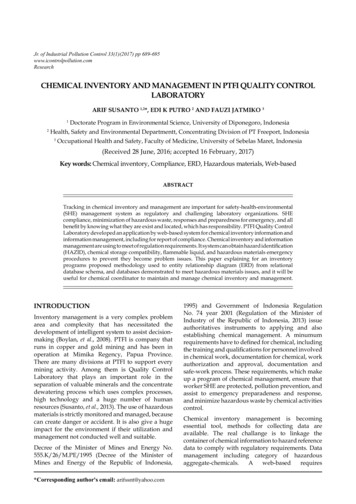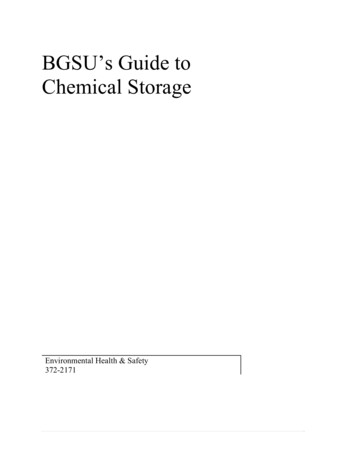
Transcription
BGSU’s Guide toChemical StorageEnvironmental Health & Safety372-2171
Chemical Storage GuidlinesGeneral Guidelines Store dry chemicals on shelves. Store flammables together. Use approved flammable storage cabinets. If possible, theyshould be ventilated. Flammable storage cabinets are only to be used to store only flammable materials or onlycombustible materials; NOT both.Store acids and bases in seperate chemical resistant cabinets. Exception: Nitric acid, when combined with acetic acid on a tile/concrete floor, willsometimes create a fire. Therefore Nitric acid must not be stored with acetic acid. Oxidizers and toxic substances should be stored near a hood. Store general cleaning materials under the sink. Non-hazardous materials should never be stored in any flammable or chemical resistantcabinets.Figure 1: An example of a flammable storage cabinet
Flinn Scientific Suggested Chemical Storage PatternStorage of laboratory chemicals presents an ongoing safety hazard. There are manychemicals that are incompatible with each other. The common method of storing theseproducts in alphabetical order sometimes results in incompatible neighbors. For example,storing strong oxidizing materials next to organic chemicals can present a hazard.A possible solution is to separate chemicals into their organic and inorganic families and thento further divide the materials into related and compatible families. Below is a list ofcompatible families.Inorganic1. Metals, Hydrides2. Acetates, Halides, Iodides, Sulfates,Sulfites, Thiosulfates, Phosphates,Halogens3. Amides, Nitrates (except AmmoniumNitrate) Nitrites, Azides4. Hydroxides, Oxides, Silicates,Carbonates, Carbon5. Sulfides, Selenides, Phosphides6. Chlorates, Bromates, Iodates,Chlorites, Hypochlorites, Perchlorates,Perchloric Acid, Peroxides, HydrogenPeroxide7. Arsenates, Cyanides, Cyanates8. Borates, Chromates, Manganates,Permanganates9. Acids (except Nitric Acid. Store NitricAcid on an isolated shelf by itself)10. Sulfur, Phosphorus, Arsenic,Phosphorus PentoxideOrganic1. Acids, Amino Acids, Anhydrides,Peracides2. Alcohols, Glycols, Surgars, Aminies,Amides, Imines, Imides3. Hygrocarbons, Esters, Aldehydes, Oils4. Ethers, Ketones, Ketenes, HalogenatedHydrocarbons, Ethylene Oxide5. Epoxy Compounds, Isocyanates6. Peroxides, Hydroperoxides, Azides7. Sulfides, Polysulfides, Sulfoxides,Nitriles8. Phenols, Cresols9. Dyes, Stains, IndicatorsNote: Volatile materials (ether, hydrocarbons, etc.) must be stored in an explosion-proofrefrigerator. The thermostat switch or light switch in a standard refrigerator may sparkand set off the volatile fume inside and thus cause an explosion.This list is not a complete list and is intended only to cover the materials possibly found in anaverage laboratory setting. This is not the only method of arranging these materials and ispurely offered as a suggestion.
Fisher Scientific Suggested Storage PatternChemAlert* Storage CodesA color-coded bar on the label of every Fisher chemical provides an instant guide to storage.The storage code color is also denoted by its initial, and spelled out for additionalclarification. The five storage colors and their descriptions are as follows:Flammable. Store in area segregated for flammable reagents.RED (R)BLUE (B)YELLOW (Y)Health Hazard. Toxic if inhaled, ingested, or absorbed throughSkin. Store in secure area.Reactive and Oxidizing Reagents. May react violently withair, water, or other substances. Store away from flammableand combustible materialsWHITE (W)Corrosive. May harm skin, eyes, mucous membranes.Store away from red-, yellow-, and blue-colored regents above.GREY (G)Presents no more than moderate hazard in any of categoriesabove. For general chemical storage.Exception. Denoted by the word “STOP.” ReagentsIncompatible with other reagents of the same color bar. Storeseparately.
Other Visual IndicatorsIf a chemical does not have the visual indicators like the Fisher Scientific ChemAlert StorageCodes, you may be able to classify the hazard by identifying the Globally HarmonizedSystem (GHS) pictograms on the label.Figure 2: GHS Pictograms that should be found on primary container label
Fisher Scientific Suggested Storage Pattern ChemAlert* Storage Codes A color-coded bar on the label of every Fisher chemical provides an instant guide to storage. The storage code color is also denoted by its initial, and spelled out for additional clarification. The five storage colors and their descriptions are as follows: Flammable.



